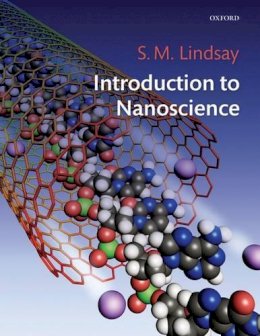
Stock image for illustration purposes only - book cover, edition or condition may vary.
Introduction to Nanoscience
Stuart Lindsay
€ 58.76
FREE Delivery in Ireland
Description for Introduction to Nanoscience
Paperback. This is the first text in nanoscience that integrates the physics, chemistry and biology of this new discipline. Each topic is treated assuming no background, but a conceptual emphasis and numerous examples and problems lead the reader to make contact with current research literature. Num Pages: 480 pages, 280 black and white line drawings and halftones. BIC Classification: PD; TBN. Category: (UP) Postgraduate, Research & Scholarly; (UU) Undergraduate. Dimension: 245 x 190 x 23. Weight in Grams: 1050.
Nanoscience is not physics, chemistry, engineering or biology. It is all of them, and it is time for a text that integrates the disciplines. This is such a text, aimed at advanced undergraduates and beginning graduate students in the sciences. The consequences of smallness and quantum behaviour are well known and described Richard Feynman's visionary essay 'There's Plenty of Room at the Bottom' (which is reproduced in this book). Another, critical, but thus far neglected, aspect of nanoscience is the complexity of nanostructures. Hundreds, thousands or hundreds of thousands of atoms make up systems that are complex enough to show what is fashionably called 'emergent behaviour'. Quite new phenomena arise from rare configurations of the system. Examples are the Kramer's theory of reactions (Chapter 3), the Marcus theory of electron transfer (Chapter 8), and enzyme catalysis, molecular motors, and fluctuations in gene expression and splicing, all covered in the final Chapter on Nanobiology. The book is divided into three parts. Part I (The Basics) is a self-contained introduction to quantum mechanics, statistical mechanics and chemical kinetics, calling on no more than basic college calculus. A conceptual approach and an array of examples and conceptual problems will allow even those without the mathematical tools to grasp much of what is important. Part II (The Tools) covers microscopy, single molecule manipulation and measurement, nanofabrication and self-assembly. Part III (Applications) covers electrons in nanostructures, molecular electronics, nano-materials and nanobiology. Each chapter starts with a survey of the required basics, but ends by making contact with current research literature.
Product Details
Publisher
Oxford University Press United Kingdom
Number of pages
472
Format
Paperback
Publication date
2009
Condition
New
Weight
1023g
Number of Pages
480
Place of Publication
Oxford, United Kingdom
ISBN
9780199544219
SKU
V9780199544219
Shipping Time
Usually ships in 4 to 8 working days
Ref
99-1
About Stuart Lindsay
Stuart Martin Lindsay Nadine and Edward Carson Professor of Physics and Chemistry Biodesign Institute Arizona State University Career Highlights: Assistant Professor, Physics, Arizona State University, 1979 Co-Founder Molecular Imaging Corporation, 1993 (now part of Agilent Technologies) Edward and Nadine Carson Presidential Chair in Physics, 2002 - Professor of Chemistry, 2003 - Consultant, Agilent Technologies, 2005 - Administrative positions Director Center for Singe Molecule Biophysics ($1M state budget, $3M external funding) Vice President, R&D, Molecular Imaging Corporation, 1994-2000 Interim Director, Center for Solid State Physics, 1991-1992 Associate Chair, Department of Physics, 1985 - 1989 Honors and awards: Fellow of the American Association for the Advancement of Science, 2003. Fellow of the American Physical Society, 1990. R&D 100 Award, 2004 Arizona Innovator of the Year (shared) 1999. Humbolt Senior Scientist Research Award (1993). ASU Awards: Outstanding Graduate Mentor (1990), Faculty Distinguished Achievement Award (2007)
Reviews for Introduction to Nanoscience
The book covers a lot of ground and combines a thoroughness of treatment with a lightness of touch. It is attractive for both undergraduate students seeking clear explanations and graduate students wanting depth.
Stephen Blundell, Oxford University
Stephen Blundell, Oxford University
